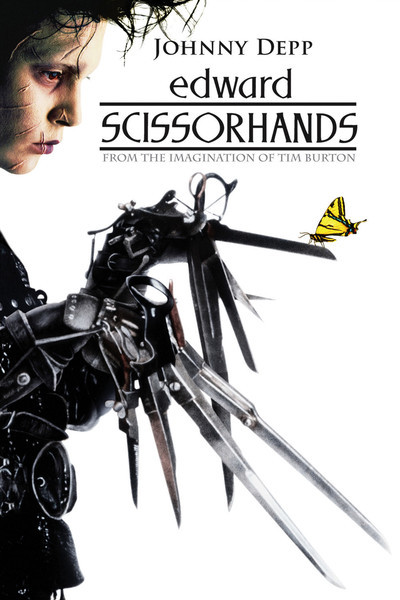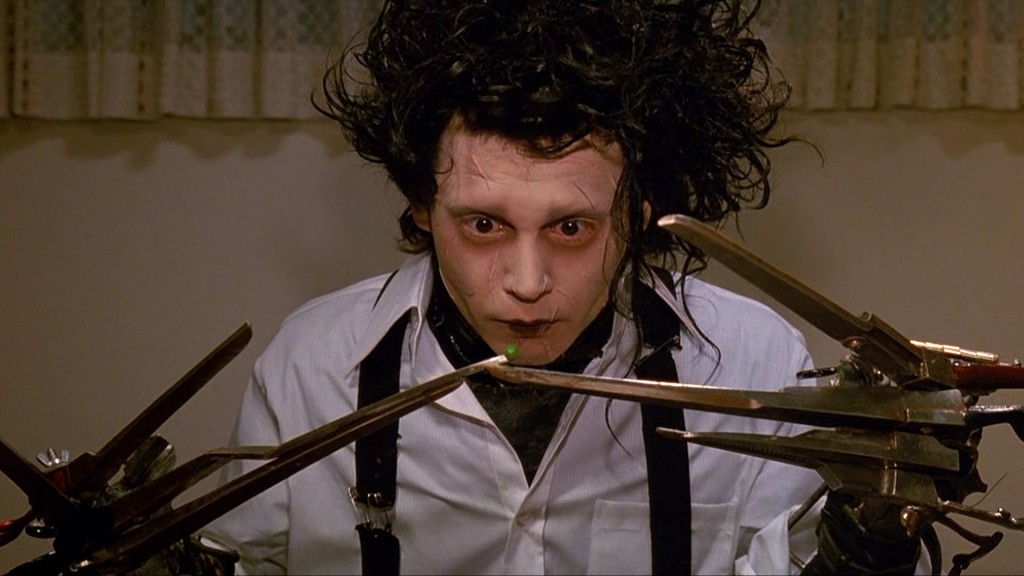 |
| Figure 1: Poster (Ebert, 1990) |
On the outside, Edward Scissorhands is a tale set in a colourful mid-century American suburb, about man with strange ways trying to fit in with the world. But the film holds a much darker tone when you look at it properly, with examinations of consumerist culture, prejudice and the pressure on those who are "different" that is backed by a haunting score by Danny Elfman.
The film starts with a kindly old woman tucking her granddaughter into a rather large and plush bed who tells her about where snow comes from. We are then given a rather strange and possibly creepy montage of working machinery, industrial themes, scissor blades and then... gingerbread cookies, culminating in a still of Vincent Price as the inventor the woman talks about In the beginning. After this we-hard cut to a picturesque American suburb of pastel colours and matching dresses where we are introduced to Peg (Dianne Wiest), the town's local door-to-door Avon representative. It is here where one of the chief themes of the movie comes in, as she is immediately rejected by the neighbor she visits because she is fine with what she was given last year and isn't that interested in "this year's line", and it turns out Peg visits every home around the suburb apart from one woman who lives in a house of burgundy who we are introduced to via seeing her play a synthesizer organ.
Desperate for sales, Peg decides to try the quite-obviously-creepy-and-unnervingly-contrasting mansion at the end of the road. At this point Peg does what the first person of every horror story seems to do and drives up to the front door of the creepy house and decides to explore without considering the fact she's trespassing or what awaits inside the creepy house - granted the front garden offsets this with an immaculate display filled with huge and beautiful topiary plants of such things as a sea monster and a giant hand complimented with colourful flowers. She continues the cliché by effectively entering without permission and goes up to a derelict room with part of the roof missing. Lowering her guard to see a collection of newspaper cuttings revolving around hands.
It is then we meet Edward, played by the master of eccentric characters Johnny Depp in his breakout lead role as the protagonist of the film. "Edward is a disarming waif with his white Kabuki makeup and wild nest of coal-black hair, and his mild-mannered temperament is directly at odds with his deformity" (Kempley, 1990), in short the kind of movie monster you just want to give a hug; His first physical interaction with Peg (letting her dab some makeup on his face to help cover up his scars) establishes him as a guy with a heart. Edward is described as being "almost complete", and it shows in more than just his hands. His movements are stiff, he speaks with a very calm and innocent demeanor and never raises his voice, when he stands its often with a slight backward arch in his posture and when his hands are not occupied there's this constant clicking and scraping as his blade-like fingers constantly twitch.
 |
| figure 2: innocent comic relief or Burton trying to guilt us about laughing at people who are different? (Le Blow) |
 |
| Figure 3: I swear Indiana Jones escaped somewhere like this via flying refrigerator. (Linekogirl, 2012) |
The film takes a much darker turn from there as Edward becomes very uneasy about how people begin treating him. Suddenly the entire neighbourhood aren't his best friends anymore - which for someone who I suppose never really had any friends until now, is a very big deal - He tries to make amends by showing off another talent - Making ice sculptures. Kim finds him brooding and performing stress-relief art and finds something magical in it, eventually getting noticed by Jim who went chasing after Kim. An accidental flick of his blades and he's on the run again which culminates in a period that is both frightening and heart-wrenching as a heartbroken Edward rampages though the suburb mutilating his topiaries and giving the only woman who hate him a good scare with a very frightening-looking topiary in her window box. There is a moment that shows he still has heart as he saves Peg's son from getting hit by the police car. In panic, the boy thrashes about as Edwards tries ot comfort him and ends up cutting his face several times, damning Edward in the eyes of the crowd around him and forcing him to run.
 |
| Figure 4: Jim's good-looking, possessive of his girlfriend, self- centred, cocky and a rebel. Our designated antagonist. (Sankles, 2014) |
In a film like this, to see a life being taken (even if it is that of an unlikable jerk like Jim) is so heart-wrenching it brings a tear to recall. Depp's innocence throughout as well as the possible accidental-way the coup de grace is done probably sells it the best, as well as the possible thought that despite his extremism, Jim was just a dumb kid who got too in over his head. I suppose he did have reason for these feelings; this fairtyale-like stranger effectively stole the heart of a girl he'd been romantically involved with for years, even if he didn't deserve her in the end he was probably too overcome with jealousy and heartbreak that he couldn't bring himself to step back and realise what he was doing.
Roger Ebert however, disagrees there was a place for such a death in this film largely due to how shoehorned it looked; "Burton and his writer, Caroline Thompson, go on autopilot [two thirds of the way through] and and paste in a standard Hollywood ending. You know what that is. The hero and the villain meet, there is a deadly confrontation, and no prizes for guessing who wins" (Ebert, 1990). It was perhaps the dissonance of the scene compared of the rest of the film as Edward had done nothing intentional to Jim to drive him to murder unlike in your standard action climax where the hero finally gets his/her chance to end the villain's reign of tyranny, madness or cruelty.
Bibliography
- Thompson, C., 2011; Edward Scissorhands 1990; Geek Speak Magazone; Published February 2011; http://geekspeakmagazine.com/archive/issue12/reviews/movies/marathon/edward_scissorhands.htm (last accessed 28th November 2014)
- Berry, J.; unknown; Empire's Edward Scissorhands Review; Empire magazone; http://www.empireonline.com/reviews/review.asp?DVDID=6549 (last accessed 28th November 2014)
- Kempley, R., 1990; 'Edward Scissorhands'; Washington Post; published 14th December 1990; http://www.washingtonpost.com/wp-srv/style/longterm/movies/videos/edwardscissorhandspg13kempley_a0a0bf.htm (last accessed 28th November 2014)
- Ebert, R., 1990; Edward Scissorhands; Roger Ebert.com, Published 14th December 1990; http://www.rogerebert.com/reviews/edward-scissorhands-1990 (last accessed 28th November 2014)
Image References
- Figure 1: [Edward Scissorhands Poster]; Roger Ebert;1990; http://static.rogerebert.com/uploads/movie/movie_poster/edward-scissorhands-1990/large_aK5Giop6mfyXhv3sFGgMZwVZqdh.jpg (last accessed 28th November 2014)
- Figure 2: [Edward eating a pea], Le Blow; http://leblow.co.uk/wp-content/uploads/2012/10/edward-Scissorhands-1024x576.jpg (last accessed 28th November 2014)
- Figure 3: [The suburb]; Linekogirl; Wordpress; 2011 http://lilnekogirl.files.wordpress.com/2012/08/edward-scissorhands-02.jpg?w=436&h=181 (last accessed 28th November 2014)
- Figure 4: [Jim]; Sankles; 2014 https://blogger.googleusercontent.com/img/b/R29vZ2xl/AVvXsEijMxADHmU5IkNOd2IsUKa2a2VCNzspH3pc4bce4S8mmddaf0HFffdeDfKqn5dhfCfg-uGUzJSPs6JjeQ4MJCl04TfW_WP7Et88iToq4FcbgurdeqVAm59YoFz1ECikKIGD_zoEGRu5ysE/s1600/edward+scissorhands55.jpg (last accessed 28th November 2014)

No comments:
Post a Comment